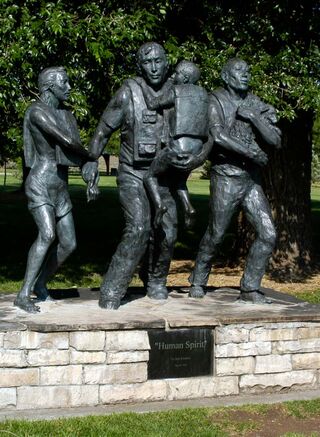Gender
Do Disasters Kill More Women Than Men?
Disaster death rates may result from societal roles.
Posted December 2, 2020 Reviewed by Gary Drevitch

An often-repeated myth is that disasters are inevitably more lethal for women and girls than for men and boys. The reality is that sometimes more women and girls die than men and boys—and sometimes it's the reverse.
To understand why this happens, we study disaster deaths disaggregated by sex and gender. Gender and sex are not the same. One major data gap in studies of disaster deaths is because more gender categories exist than simply differentiating between women/girls and men/boys.
Many conclusions about disaster deaths were nonetheless reaffirmed through analyses of the Indian Ocean tsunami of 26 December 2004 which killed over 200,000 people. In some places, four-fifths of fatalities were women.
Aceh, Indonesia was devastated. Many women died there because they were waiting at the coast for their husbands to return with the morning’s catch from fishing. This does not say that women are inherently more vulnerable than men; just that the women died due to their societal roles.
The tsunami could have hit earlier when the men were at the shoreline, just going out to sea. Then more men might have died. The tsunami could have hit later, while the fish were being offloaded, meaning that death rates might have been more equal between women and men.
These death tolls say little about the overall relative vulnerability of different sexes or of different genders. They are a product of differentiated societal roles epitomizing wider and deeper concerns of unresolved disaster vulnerabilities.
During inland floods in the USA, more men than women typically die. Part of this result comes from the high proportion, perhaps half, of the country’s inland flood-related deaths being trained or untrained rescuers attempting to help someone else. Men are far more numerous among these would-be rescuers than women. They might be trained such as firefighters or untrained bystanders driven by machismo and societal expectations of men sacrificing themselves: "Women and children first."
This does not say that men are inherently more vulnerable than women, just that the men died due to their societal roles. Vulnerabilities formed by sex-based and gender-based assumptions, expectations, and roles, including those beyond binary gender constructions, require deeper investigation.
In the USA during flash floods, typically more than half of recorded deaths happen in vehicles. Data are inadequate on factors including the influence of alcohol and marijuana; passengers goading drivers to zip through the churning waters; drivers desperately trying to reach their kids at school or other family members; and who is reached by the “Turn around, don’t drown” message.
Since vehicles are easily swept away in even shallow, flowing water, the rule is to never enter floodwater without training and equipment, whether walking, cycling, driving, skateboarding, or with other modes of transport. When people give so many reasons for attempting to reach the other side, what emerges from expectations of how each sex or gender ought to behave?
Patterns of expected sex-based or gender-based actions repeat across all hazards. They lead to widely varying casualty types and rates when comparing sexes and genders across disasters. Many causal factors remain poorly understood.
As a storm surge or wildfire races toward them, men are often expected to stay behind to protect property, including buildings, possessions, and livestock. They might be fully aware of the danger, yet feel responsible for preserving home and livelihood.
Meanwhile, in some places, women and girls are not permitted to be out alone, needing a man to accompany them. Or they might fear going out alone due to threats of violence and assault. They could receive and understand a warning, knowing exactly what they should do, but be unable to put their knowledge into practice.
Men and boys—as with women, girls, and all genders—also experience violence and assault. These threats affect their decisions to avoid evacuating or to avoid a local shelter.
Those who are menstruating end up forced into vulnerable situations due to lack of hygiene products and stigmas around periods. They can be isolated from their families, unwelcome in communal areas, or ostracized from vital information and safe locales.
Women must frequently wear clothes which can impede rapid movement while having caring responsibilities which slow down responses. They would never wear fewer or different clothes in order to survive, nor would they abandon the children or elderly for whom they are responsible. Meanwhile, men frequently wish to take more responsibility for caring, but it is discouraged as not being manly enough.
These social norms create sex-based and gender-based vulnerabilities. The myth of women and girls dying more than men and boys in all disasters needs to be overturned. Instead, different sexes and different genders are forced to be vulnerable in different ways, leading to different disaster death tolls. Working together for equity in roles and expectations will pave the way for reducing the chance of dying in disasters for everyone.
References
Gaillard, JC, K. Sanz, B.C. Balgos, S.N.M. Dalisay, A. Gorman‐Murray, F. Smith, and V. Toelupe. 2017. Beyond men and women: a critical perspective on gender and disaster. Disasters, vol. 41, no. 3, pp. 429-447.
Jonkman, S.N. and I. Kelman. 2005. "An Analysis of Causes and Circumstances of Flood Disaster Deaths". Disasters, vol. 29, no. 1 (March), pp. 75-97.
Kelman, I. and S.N. Jonkman. 2007. "Disaster Deaths Research Challenges". Presentation at the Hazards and Disasters Researchers Meeting, Boulder, Colorado, USA, 11-12 July 2007.
Sanz, K., I. Kelman, A. Adebola, J. Chacon, R. Sanchez, and Gender and Disaster Network Members. 2009. "From the Inside Out: Reflections on Gendering Disaster Risk Reduction". Regional Development Dialogue, vol. 30, no. 1, pp. 14-21.




